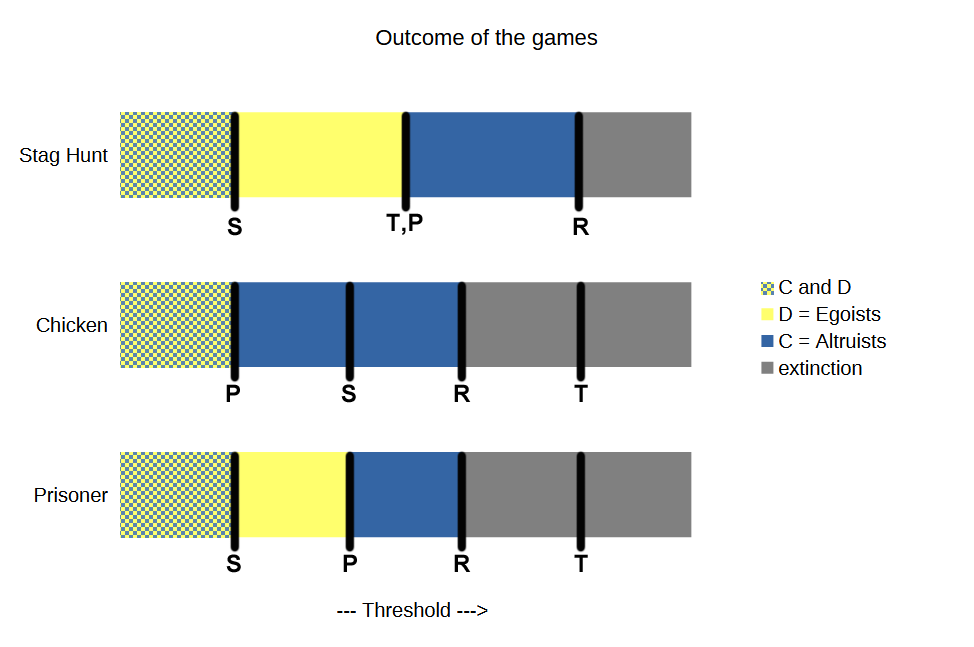Results and Discussion Here is a brief summary of the most important results and their significance in the example setups.
For a better overview, here is the general matrix from the introduction again:
| C | D | |
|---|---|---|
| C | R (reward) | S (sucker) |
| D | T (temptation) | P (punishment) |
Prisoner's dilemma
Population development at different selection thresholds:- threshold ≤ S ... no selection pressure for C and D, random distribution
- S < threshold ≤ P ... D prevails
- P < threshold ≤ R ... C prevails
- R < threshold ≤ T ... Population is dying out
- T < threshold ... Population is dying out
A prisoner's dilemma has only one Nash equilibrium, namely when all players are D players.
However, our simulation of a group-structured population with a global selection threshold shows that a population of C players develops stably if the selection threshold is greater P (value for D playing against another D) but less or equal R (the value a C player receives when interacting with a D player).
Game of Chicken
Population development at different selection thresholds:- threshold ≤ P ... no selection pressure for C and D, random distribution
- P < threshold ≤ S ... C prevails
- S < threshold ≤ R ... C prevails
- R < threshold ≤ T ... Population is dying out
- T < threshold ... Population is dying out
Like in prisoner's dilemma, the dynamics of group-structured population also dramatically supports the C players in the game of chicken. Here, stable C populations develop even at threshold values from P (D against other D) to R (C against C).
Stag Hunt
Population development at different selection thresholds:- threshold ≤ S ... no selection pressure for C and D, random distribution
- S < threshold ≤ T and P ... D prevails
- T or P < threshold ≤ R ... C prevails
- R < threshold ... Population is dying out

Example "evo prison"
The example setup “evo prison” shows that under the preset prisoner's dilemma, a stable C population can develop even from a pure D population. Under the same conditions, a game of chicken also leads to this result.This proves that structuring the population can not only preserve altruistic traits, but also that these traits can spread even in a population that was originally egotistical.
References and further reading
Ackermann, M., Stecher, B., Freed, N.E., Songhet, P., Hardt, W.-D., Doebeli, M., 2008. Self-destructive cooperation mediated by phenotypic noise. Nature 454, 987–990. https://doi.org/10.1038/nature07067
Cremer, J., Melbinger, A., Wienand, K., Henriquez, T., Jung, H., Frey, E., 2019. Cooperation in Microbial Populations: Theory and Experimental Model Systems. Journal of Molecular Biology 431, 4599–4644. https://doi.org/10.1016/j.jmb.2019.09.023
Darwin, C., 1888. The descent of man: and selection in relation to sex. John Murray, Albemarle Street.
Dugatkin, L.A., 2017. The evolution of altruism. Vestn. VOGiS 21, 487–491. https://doi.org/10.18699/VJ17.267
Fletcher, J.A., Doebeli, M., 2009. A simple and general explanation for the evolution of altruism. Proc. R. Soc. B. 276, 13–19. https://doi.org/10.1098/rspb.2008.0829
Fletcher, J.A., Zwick, M., 2004. Strong altruism can evolve in randomly formed groups. Journal of Theoretical Biology 228, 303–313. https://doi.org/10.1016/j.jtbi.2004.01.004
Hamilton, W.D., 1964. The genetical evolution of social behaviour. I. Journal of Theoretical Biology 7, 1–16. https://doi.org/10.1016/0022-5193(64)90038-4
Hardin, G., The Tragedy of the Commons. Science162,1243-1248(1968). DOI:10.1126/science.162.3859.1243
Killingback, T., Bieri, J., Flatt, T., 2006. Evolution in group-structured populations can resolve the tragedy of the commons. Proc. R. Soc. B. 273, 1477–1481. https://doi.org/10.1098/rspb.2006.3476
Kropotkin, P., 1902. Mutual aid: A factor of evolution. McClure Phillips & Co.
Maynard Smith, J., Price, G. The Logic of Animal Conflict. Nature 246, 15–18 (1973). https://doi.org/10.1038/246015a0
Nowak, M.A., 2012. Evolving cooperation. J Theor Biol 299, 1–8. https://doi.org/10.1016/j.jtbi.2012.01.014
Nowak, M. A. & May, R. M., 1992. Evolutionary games and spatial chaos. Nature 359, 826–829. (doi:10.1038/ 359826a0)
Nowak, M. A., Tarnita, C. E., Antal T., 2010. Evolutionary dynamics in structured populations. Phil. Trans. R. Soc. B. 365, 19–30 (doi:10.1098/rstb.2009.0215)
Okasha, S., 2020. Biological Altruism, in: Zalta, E.N. (Ed.), The Stanford Encyclopedia of Philosophy. Metaphysics Research Lab, Stanford University.
Pepper, J.W., 2000. Relatedness in Trait Group Models of Social Evolution. Journal of Theoretical Biology 206, 355–368. https://doi.org/10.1006/jtbi.2000.2132
Price, G.R., 1970. Selection and Covariance. Nature 227, 520–521. https://doi.org/10.1038/227520a0
Sigmund, K., Hauert, C., 2002. Altruism. Current Biology 12, R270–R272. https://doi.org/10.1016/S0960-9822(02)00797-2
Sober, E., Wilson, D.S., 1998. Unto Others: The Evolution and Psychology of Unselfish Behavior, Emersion: Emergent Village Resources for Communities of Faith Series. Harvard University Press.
Steiner, K.F., 2021. The Good, the Bad and the Stochastic: How Living in Groups Innately Supports Cooperation. bioRxiv 2021.02.21.431661; doi: https://doi.org/10.1101/2021.02.21.431661
Steiner, K.F., 2024. Altruism pays off in group-structured populations through probable reciprocity. bioRxiv 2024.01.20.575560. doi: https://doi.org/10.1101/2024.01.20.575560
Trivers, R.L., 1971. The Evolution of Reciprocal Altruism. The Quarterly Review of Biology 46, 35–57. https://doi.org/10.1086/406755
Wilensky, U., 1999. NetLogo. http://ccl.northwestern.edu/netlogo/. Center for Connected Learning and Computer-Based Modeling, Northwestern University. Evanston, IL.
Wilson, D.S., 1975. A theory of group selection. Proc. Natl. Acad. Sci. U.S.A. 72, 143–146. https://doi.org/10.1073/pnas.72.1.143
Wilson, D.S., Wilson, E.O., 2008. Evolution “for the Good of the Group.” American Scientist 96, 380–389.